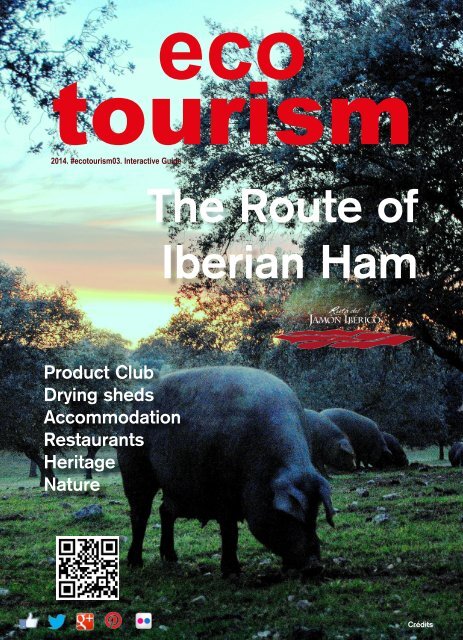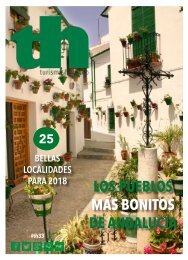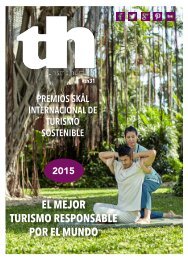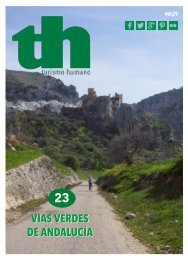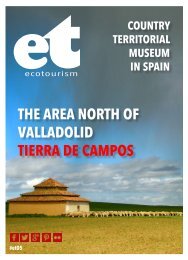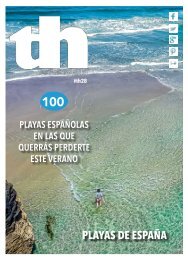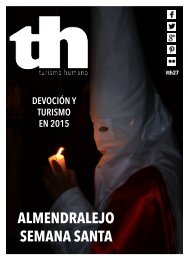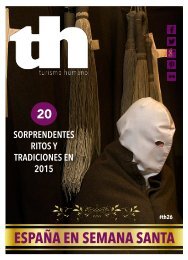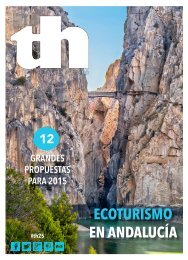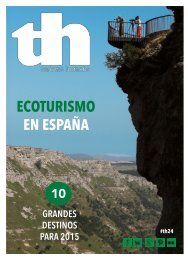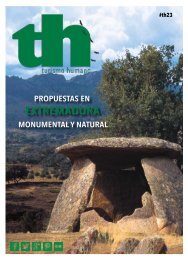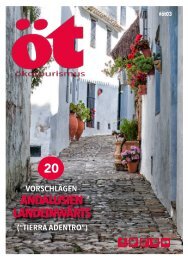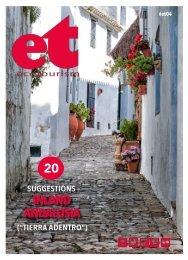Eco Tourism 03. The Route of Iberian Ham
Iberian Ham or jamón ibérico has become very fashionable. The main gourmet chains and prestigious restaurateurs all over the world offer Iberian ham as one of the most exquisite and exclusive products. It is only produced in a few regions on the Iberian peninsula of mainland Spain. The Route of Iberian Ham comes into being as a product of food tourism direct from the countryside and culture of the people along the route.
Iberian Ham or jamón ibérico has become very fashionable. The main gourmet chains and prestigious restaurateurs all over the world offer Iberian ham as one of the most exquisite and exclusive products. It is only produced in a few regions on the Iberian peninsula of mainland Spain. The Route of Iberian Ham comes into being as a product of food tourism direct from the countryside and culture of the people along the route.
Create successful ePaper yourself
Turn your PDF publications into a flip-book with our unique Google optimized e-Paper software.
eco<br />
tourism<br />
2014. #ecotourism<strong>03.</strong> Interactive Guide<br />
<strong>The</strong> <strong>Route</strong> <strong>of</strong><br />
<strong>Iberian</strong> <strong>Ham</strong><br />
Product Club<br />
Drying sheds<br />
Accommodation<br />
Restaurants<br />
Heritage<br />
Nature<br />
#ecotourism Crédits 1
<strong>The</strong> <strong>Route</strong> <strong>of</strong> <strong>Iberian</strong> <strong>Ham</strong><br />
Other magazines <strong>of</strong> interest<br />
2014. #ecotourism01. Interactive Guide<br />
<strong>The</strong> best<br />
routes for<br />
birdwatching<br />
in the<br />
Castile–Leon<br />
region <strong>of</strong><br />
Spain<br />
Staff www.turismohumano.com<br />
<strong>The</strong> TRINO Project<br />
Birdwatching<br />
<strong>Tourism</strong><br />
www.birdwatchinginspain.com Turismo Humano 1<br />
2 #ecotourism
Product Club<br />
R<br />
Créditos<br />
Promotional video <strong>of</strong> the <strong>Route</strong> <strong>of</strong> <strong>Iberian</strong> <strong>Ham</strong><br />
<strong>The</strong> product club <strong>of</strong> the <strong>Route</strong> <strong>of</strong> the <strong>Iberian</strong> <strong>Ham</strong><br />
Artisan, traditional and sustainable cuisine<br />
<strong>Iberian</strong> <strong>Ham</strong> or jamón ibérico has become<br />
very fashionable. <strong>The</strong> main gourmet<br />
chains and prestigious restaurateurs<br />
all over the world <strong>of</strong>fer <strong>Iberian</strong> ham as<br />
one <strong>of</strong> the most exquisite and exclusive<br />
products. It is only produced in a few regions<br />
on the <strong>Iberian</strong> peninsula <strong>of</strong> mainland<br />
Spain. <strong>The</strong> <strong>Route</strong> <strong>of</strong> <strong>Iberian</strong> <strong>Ham</strong><br />
comes into being as a product <strong>of</strong> food<br />
tourism direct from the countryside and<br />
culture <strong>of</strong> the people along the route.<br />
<strong>The</strong> product club <strong>Route</strong> <strong>of</strong> the <strong>Iberian</strong><br />
<strong>Ham</strong> makes it possible for visitors to enjoy<br />
a unique experience that consists <strong>of</strong><br />
visiting the four Protected Designation<br />
<strong>of</strong> Origin areas <strong>of</strong> <strong>Iberian</strong> ham production<br />
(Dehesa de Extremadura, Jamón<br />
de Huelva, Guijuelo and Los Pedroches)<br />
that cover three autonomous regions<br />
(Castilla y León, Extremadura and Andalucía)<br />
and five provinces: Salamanca,<br />
Cáceres, Badajoz, Huelva and Córdoba.<br />
Tourists can visit and enjoy the landscape<br />
<strong>of</strong> the dehesa pastures by visiting<br />
pig farms, museums and interpretation<br />
centres as well as drying sheds so they<br />
can see the production process, try<br />
and enjoy jamón ibérico in restaurants<br />
and shops and find accommodation in<br />
these areas. However the <strong>Route</strong> <strong>of</strong> <strong>Iberian</strong><br />
<strong>Ham</strong> also includes beautiful places,<br />
both nature spots as well as historic<br />
and cultural sites that mean visitors can<br />
enjoy the heritage, world and culture <strong>of</strong><br />
<strong>Iberian</strong> ham and the places linked to its<br />
production.<br />
Attention: All the links in the magazine<br />
take you to pages in Spanish<br />
#ecotourism 3
<strong>The</strong> <strong>Route</strong> <strong>of</strong> <strong>Iberian</strong> <strong>Ham</strong><br />
Remains <strong>of</strong> the Roman Villa "Los Terminos” in Monroy (Cáceres) © Eduardo Estéllez<br />
4 #ecotourism
<strong>The</strong> territory<br />
#ecotourism 5
<strong>The</strong> <strong>Route</strong> <strong>of</strong> <strong>Iberian</strong> <strong>Ham</strong><br />
<strong>The</strong> <strong>Iberian</strong> Pig in freedom in the dehesa pasture <strong>of</strong> Sierra de Aracena and Picos de Aroche. Photo: © Jesuskym<br />
6 #ecotourism
<strong>The</strong> territory<br />
<strong>The</strong> breeding and production<br />
area on the<br />
<strong>Route</strong> <strong>of</strong> the <strong>Iberian</strong> <strong>Ham</strong><br />
is in the Autonomous<br />
Communities <strong>of</strong> Andalucía,<br />
Castilla y León and<br />
Extremadura.<br />
<strong>The</strong>se areas are marked<br />
out by the Regulating<br />
Council <strong>of</strong> the Designation<br />
<strong>of</strong> Origin <strong>of</strong> the <strong>Iberian</strong><br />
ham. Guijuelo, la<br />
Dehesa de Extremadura,<br />
Jamón de Huelva and Los<br />
Pedroches are the four<br />
areas with Designation <strong>of</strong><br />
Origin at present.<br />
In the provinces <strong>of</strong> Salamanca,<br />
Cáceres, Badajoz,<br />
Huelva and Córdoba<br />
there are 307 towns and<br />
villages that are authorised<br />
by the Regulating<br />
Council to establish drying<br />
sheds. <strong>The</strong>se towns and<br />
villages make up the “areas<br />
<strong>of</strong> development and<br />
fattening” <strong>of</strong> the <strong>Iberian</strong><br />
pigs.<br />
<strong>The</strong> dehesa pastures<br />
Without the dehesa grazing<br />
land <strong>Iberian</strong> ham<br />
would not exist. This ecoan.<br />
To the right, corn oak tree. Photo: © Jinete Vetón.<br />
#ecotourism 7
<strong>The</strong> <strong>Route</strong> <strong>of</strong> <strong>Iberian</strong> <strong>Ham</strong><br />
“La Terrona”, unique tree and natural monument with around 800 years old, It’s found in the Montánchez route<br />
© Pilar F.G. To the right, free range <strong>Iberian</strong> pig in the dehesa pasture <strong>of</strong> Extremadura. Photo: © Jinete Vetón<br />
8 #ecotourism
<strong>The</strong> dehesa pastures<br />
system provides the special characteristics<br />
that only exist in this wooded<br />
pastureland cultivated by man and<br />
capable <strong>of</strong> harmonising human occupation<br />
with the conservation <strong>of</strong> the<br />
environment and its sustainable development<br />
with agricultural usage.<br />
It is one <strong>of</strong> the most singular ecosystems<br />
in the world that is found in Spain along<br />
a strip that runs from Salamanca to<br />
Sierra Morena and West Andalucía, although<br />
there are more isolated areas in<br />
Castilla-La Mancha, Madrid and Castilla<br />
y León.<br />
<strong>The</strong> colours, aromas and sensations immerse<br />
us in a nature area with a distinctive<br />
and suggestive beauty that invites<br />
us to walk through the countryside and<br />
enjoy its diverse flora and fauna. You<br />
can find 60 different bird species that<br />
nest here and over 20 varieties <strong>of</strong> mammals.<br />
<strong>The</strong> characteristics <strong>of</strong> the trees<br />
make it one <strong>of</strong> the zones with the greatest<br />
biodiversity on the <strong>Iberian</strong> Peninsula.<br />
and it is considered the oldest holm oak in Spain. Photo:<br />
It is the ideal place for hiking and biking,<br />
on route you will come across an<br />
important cultural heritage <strong>of</strong> noteworthy<br />
buildings, farming traditions, castles,<br />
megalithic monuments, medieval<br />
bridges, Roman roads and many other<br />
attractive features.<br />
#ecotourism 9
<strong>The</strong> <strong>Route</strong> <strong>of</strong> <strong>Iberian</strong> <strong>Ham</strong><br />
Architecture in the dehesa<br />
pastureland<br />
<strong>The</strong> civil, religious and folk architecture<br />
tells us about life in the dehesa, the<br />
beliefs <strong>of</strong> the people and their social<br />
administration. You can still see and visit<br />
remains <strong>of</strong> ancient castles and other<br />
defensive forts that date from Moorish<br />
times like the watch towers and border<br />
posts.<br />
<strong>The</strong>re are many civil buildings dating<br />
from the Middle Ages that tell us about<br />
the importance <strong>of</strong> the dehesa pastures<br />
in the transhumance <strong>of</strong> stock between<br />
the north and south <strong>of</strong> the Peninsula.<br />
<strong>The</strong> wool trade, with the fleeces <strong>of</strong> Merino<br />
sheep, required an infrastructure in<br />
the dehesa in the form <strong>of</strong> tracks, roads,<br />
paths, bridges and cattle grids.<br />
On the other hand, many shrines were<br />
built and dedicated to different saints,<br />
to take care <strong>of</strong> the people and their<br />
belongings and where people could go<br />
to religious services.<br />
<strong>The</strong>re are many examples <strong>of</strong> folk architecture<br />
for livestock in the dehesa pastures<br />
like the “tinaos”, a kind <strong>of</strong> covered<br />
passage, pigsties, corrals, fenced and<br />
stone enclosures, huts, wells, waterwheels,<br />
etc. <strong>The</strong> pigsty, for example,<br />
protects the pigs from the inclemency<br />
<strong>of</strong> the weather and they are built <strong>of</strong><br />
stone or clay. Farms, labourers’ cottag-<br />
To the left, traditional architecture <strong>of</strong> the dehesa pasture in E<br />
cuescar (Cáceres), a beautiful example <strong>of</strong> medieval religious a<br />
10 #ecotourism
<strong>The</strong> dehesa pastures<br />
xtremadura. Photo: © Juanma Mateos. Over this lines, Mozarab church <strong>of</strong> Santa Lucia del Trampal in Alrchitecture.<br />
Photo: © Mari Ángeles y Jesús<br />
#ecotourism 11
<strong>The</strong> <strong>Route</strong> <strong>of</strong> <strong>Iberian</strong> <strong>Ham</strong><br />
es, hydraulic constructions and water<br />
mills are farm related buildings. In these<br />
areas you can see people carrying out<br />
traditional tasks like cork harvesting,<br />
making charcoal and farming the herds<br />
<strong>of</strong> <strong>Iberian</strong> pigs.<br />
<strong>The</strong> <strong>Iberian</strong> pig<br />
<strong>The</strong> leading role <strong>of</strong> this tourism product<br />
is an animal that has been symbolic in<br />
numerous ancient cultures. <strong>The</strong> <strong>Iberian</strong><br />
pig breed dates back 3000 years to be<br />
precise, when pigs brought by the Phoenicians<br />
from the Middle East were used<br />
for cross breeding. <strong>The</strong> <strong>Iberian</strong> pig has<br />
three breeds: Black, red and the Jabugo<br />
pied (Huelva).<br />
<strong>The</strong> feed is a key factor in <strong>Iberian</strong> pig<br />
farming. After they leave the sow, the<br />
piglets are fed on stubble from cereal<br />
crops and the sparse remains in the<br />
countryside, the most important time<br />
is when the pigs graze freely in the dehesa<br />
pastures when the acorns begin<br />
to fall from the oak trees. This system <strong>of</strong><br />
traditional fattening is called mountain<br />
free range or montanera.<br />
<strong>The</strong> fattening process consists <strong>of</strong> letting<br />
the pigs graze in the dehesa pasture<br />
scattered with acorns from the cork<br />
and holm oak groves that are their main<br />
food. Depending on weather conditions,<br />
the traditional period begins in<br />
October to November and finishes in<br />
To the left, the cottage represents the most traditional archit<br />
period in the dehesa pasture in Caceres. Photo: © José Bay<br />
12 #ecotourism
<strong>The</strong> <strong>Iberian</strong> pig<br />
ecture <strong>of</strong> dehesa pasture. Photo: © Robby25. Over this lines, free range <strong>Iberian</strong> pig during the fodder feeding<br />
ón<br />
#ecotourism 13
<strong>The</strong> <strong>Route</strong> <strong>of</strong> <strong>Iberian</strong> <strong>Ham</strong><br />
<strong>The</strong> <strong>Iberian</strong> Pig in freedom in the dehesa pasture <strong>of</strong> Los Pedroches (Córdoba). Photo: © Javier<br />
14 #ecotourism
<strong>The</strong> <strong>Iberian</strong> pig<br />
February to March which is when the<br />
acorns are ready. <strong>The</strong> amount <strong>of</strong> acorns<br />
the <strong>Iberian</strong> pig eats will determine the<br />
quality <strong>of</strong> the final product. It is recommended<br />
that each <strong>Iberian</strong> pig puts on<br />
an average <strong>of</strong> 57.5 kilos.<br />
<strong>The</strong>re are three different systems <strong>of</strong> fattening<br />
the pigs.<br />
• Grain. <strong>The</strong> pigs eat concentrated<br />
commercial feed or meal.<br />
• Free range fattening. <strong>The</strong> traditional<br />
fattening process consists <strong>of</strong> taking<br />
advantage <strong>of</strong> all the resources <strong>of</strong> the<br />
dehesa pastures.<br />
• Mixed feed or recebo. This term is<br />
applied to pigs that have grazed<br />
free range but the feed has been<br />
made up with grain because there<br />
has not been enough acorns.<br />
<strong>The</strong> quality <strong>of</strong> the product is guaranteed<br />
thanks to the perfect combination<br />
between the acorn feed and the exercise<br />
the animal does. After the fattening<br />
period, three to five months, the pig can<br />
fatten up to 57.5 kilos.<br />
Farrowing takes place in June and<br />
December and each litter ranges from<br />
six to eight piglets. Depending on the<br />
season, the pigs are classified in Spain<br />
as “yerbizos” (February to March), “agostones”<br />
(August) and “marceños” (April<br />
to May).<br />
In the rearing period the bases are established<br />
for the definite make up <strong>of</strong> the<br />
animal. First <strong>of</strong> all, the pig with a weight<br />
<strong>of</strong> between 35 and 70 kilos subsequently<br />
develops into a fattened pig <strong>of</strong> between<br />
70 and over 100 kilos.<br />
#ecotourism 15
<strong>The</strong> <strong>Route</strong> <strong>of</strong> <strong>Iberian</strong> <strong>Ham</strong><br />
Acorns<br />
<strong>The</strong> fruit <strong>of</strong> the oak, the holm oak and<br />
other trees <strong>of</strong> the quercus genus make<br />
up the staple food <strong>of</strong> the <strong>Iberian</strong> breed<br />
<strong>of</strong> pig raised in the dehesa pastures. <strong>The</strong><br />
acorn is <strong>of</strong> great importance for feeding<br />
the adult pig because it is this that gives<br />
the best quality <strong>of</strong> acorn-cured ham.<br />
<strong>The</strong> best acorns are the sweet fruits<br />
<strong>of</strong> the oak tree that have a brownish<br />
colour and are a delicacy for the <strong>Iberian</strong><br />
pig that is continuously rooting for<br />
acorns in groups. On the other hand,<br />
the “not so sweet” acorns serve to put<br />
on pork fat and they also give a characteristic<br />
taste and aroma to the animal.<br />
A pig fattened extensively in the dehesa<br />
pastures eating 10 kg <strong>of</strong> acorns a<br />
day can put on up to a kilo a day. An<br />
oak grove dedicated to pig farming<br />
can produce between 400 and 900 kg/<br />
hectare <strong>of</strong> acorns a year and an oak<br />
around 15 kg a year.<br />
<strong>The</strong> combination <strong>of</strong> grass and acorns<br />
provides the taste, colour and aroma<br />
characteristic <strong>of</strong> <strong>Iberian</strong> ham. At the<br />
start <strong>of</strong> the period when the pigs graze<br />
freely is when the meat is being produced,<br />
this is when the fat begins to<br />
marble the meat.<br />
To the left, acorns in the dehesa pasture ground, the basic fo<br />
16 #ecotourism
Acorns<br />
odstuff <strong>of</strong> the <strong>Iberian</strong> pig. Photo: © Multivac42. Over this lines Oak’s acorns. Photo: © Ferrán Turmo<br />
#ecotourism 17
<strong>The</strong> <strong>Route</strong> <strong>of</strong> <strong>Iberian</strong> <strong>Ham</strong><br />
<strong>The</strong> iberian <strong>Ham</strong> treatment requires special cares and conditions that concerns the relative humidity and the air<br />
18 #ecotourism
Curing<br />
Curing<br />
After the free range grazing,<br />
the pig is slaughtered<br />
in the traditional way or<br />
industrially to reduce stress<br />
so that the quality <strong>of</strong> the<br />
meat is not affected. At<br />
the time <strong>of</strong> slaughter the<br />
blood is used for making<br />
cold meats and preserves.<br />
Next it is washed and<br />
then cut into hams and<br />
shoulders to start the curing<br />
process the next day.<br />
Before you obtain the<br />
<strong>Iberian</strong> ham, the leg is<br />
prepared and part <strong>of</strong> the<br />
fat, skin and meat from<br />
the outside is taken away.<br />
All this makes the characteristic<br />
“V” on the skin.<br />
flows. Photo: © Plan Dinamización Jamón Dehesas de Extremadura<br />
Although technological<br />
innovations have been<br />
incorporated into the<br />
process, the elaboration<br />
<strong>of</strong> the <strong>Iberian</strong> ham follows<br />
a delicate and traditional<br />
selective process. <strong>The</strong><br />
climate conditions during<br />
the curing process (drying<br />
shed and cellar) make<br />
the product unique and<br />
famous all over the world.<br />
#ecotourism 19
<strong>The</strong> <strong>Route</strong> <strong>of</strong> <strong>Iberian</strong> <strong>Ham</strong><br />
Curing stages <strong>of</strong> <strong>Iberian</strong> ham<br />
• Salting. <strong>The</strong> hams are soaked in brine<br />
at a low temperature (between 1º-<br />
5ºC) with humidity <strong>of</strong> 80%-90% for 9 to<br />
14 days.<br />
• Rinsing. This process gets rid <strong>of</strong> the<br />
salt attached to the outside <strong>of</strong> the<br />
ham. It also eliminates any remaining<br />
traces <strong>of</strong> blood.<br />
• Post salting. Depending on the size<br />
and weight <strong>of</strong> the hams, the normal<br />
time is between 60 and 75 days and<br />
can even be extended to 90. <strong>The</strong><br />
slow penetration <strong>of</strong> the salt into the<br />
muscles continues. <strong>The</strong> hams are<br />
kept at temperatures between 3º<br />
and 6º C with humidity <strong>of</strong> 80%-90%.<br />
• Drying. It is dried by controlled air<br />
circulation for three to seven months<br />
to achieve the final stabilization <strong>of</strong><br />
the ham. <strong>The</strong> humidity slowly disappears<br />
with this process. At a higher<br />
temperature (15º-30ºC) an even<br />
distribution <strong>of</strong> the fat is acquired and<br />
this gives rise to the taste and aroma<br />
<strong>of</strong> the ham.<br />
• Drying and curing in cellars. It is the<br />
final stage <strong>of</strong> the process and it<br />
consists in hanging in the still air, at<br />
temperatures between 10º and 20ºC<br />
with room humidity <strong>of</strong> 60% to 80%.<br />
<strong>The</strong> fungus that appears on the outside<br />
<strong>of</strong> the ham provides the characteristic<br />
smell <strong>of</strong> the <strong>Iberian</strong> ham. <strong>The</strong><br />
minimum stay in the cellar depends<br />
on weight and varies between 6 and<br />
18 months.<br />
Depending on the weight <strong>of</strong> the ham,<br />
the total process time to get an <strong>Iberian</strong><br />
ham in perfect condition and ready to<br />
eat is from 20 to 24 months. S<strong>Ham</strong>s drying place in Béjar (Salamanca). Photo: © Jose Mª<br />
20 #ecotourism
Curing<br />
Rada<br />
#ecotourism 21
<strong>The</strong> <strong>Route</strong> <strong>of</strong> <strong>Iberian</strong> <strong>Ham</strong><br />
22 #ecotourism
Parts <strong>of</strong> the <strong>Iberian</strong> ham<br />
• “Maza”. This is the most succulent<br />
part where most <strong>of</strong> the meat is and<br />
where you normally begin to cut and<br />
use the ham.<br />
• “ Contramaza”. Opposite side to the<br />
“maza”. This part has very little fat.<br />
• “Babilla”. This is the least juicy part <strong>of</strong><br />
the <strong>Iberian</strong> ham between the tibia<br />
and the femur. <strong>The</strong> experts recommend<br />
you start to use this part <strong>of</strong> the<br />
ham first if you are going to use it<br />
slowly to make sure it does not lose its<br />
smell and taste.<br />
• “Punta”. Top end <strong>of</strong> the ham. Tasty<br />
with a lot <strong>of</strong> fat. More salty if it has<br />
not been protected by a yellow coat<br />
<strong>of</strong> fat.<br />
• Shank ("Jarrete" and "Caña"). <strong>The</strong><br />
meat around the trotter is hard,<br />
stringy and has a lot <strong>of</strong> oil. Very good<br />
for small pieces <strong>of</strong> ham for cooking<br />
stews.<br />
Utensils for carving<br />
Carving the ham follows precise rites so<br />
you get all the flavour. At different fairs<br />
and festivals celebrated around ham<br />
there are carving competitions with<br />
very good prizes. This is why the utensils<br />
should be carefully chosen.<br />
• Pr<strong>of</strong>essional ham knife. A ham knife<br />
should have a long, narrow blade<br />
that is good and sharp to cut thin<br />
slices.<br />
• Short carving knife. Short and narrow<br />
with a strong blade so you can make<br />
slits and to cut round bones when<br />
necessary.<br />
• Fillet knife. Wide, medium width and<br />
resistant blade. Used to cut <strong>of</strong>f the<br />
skin.<br />
• Knife sharpener. It eliminates small<br />
nicks and keeps each knife perfectly<br />
sharpened.<br />
• <strong>The</strong> ham stand. It makes it easy to<br />
turn the ham and carve in a straight<br />
line keeping the cut level.<br />
Carving process<br />
Carving<br />
• First <strong>of</strong> all. Before cleaning the ham,<br />
you make a deep cut (4 cm.) at the<br />
hock by the shank. Afterwards you<br />
proceed to cut <strong>of</strong>f the skin and fat.<br />
• Where to start. If you are going to<br />
eat the ham within 3 days you start<br />
to carve the ham at the meatiest<br />
part, “la maza”. On the other hand,<br />
if you are going to eat the ham at<br />
home you should start at the “babilla”.<br />
• Preparation. Once you have removed<br />
the top part <strong>of</strong> the ham you<br />
go on to take the skin <strong>of</strong>f the sides.<br />
• Slicing. You use the ham knife for this.<br />
<strong>The</strong> slices should be very thin and<br />
medium sized. You should carve all<br />
the parts <strong>of</strong> the ham to get more out<br />
<strong>of</strong> it. When you get to the bone, you<br />
should make a clean cut to separate<br />
the meat from the bone keeping the<br />
meat level so that the slices come <strong>of</strong>f<br />
easily.<br />
• Turning the ham over. When the slices<br />
get down to the femur it is time to<br />
turn it over and place it on the ham<br />
stand with the trotter facing down.<br />
• Finishing <strong>of</strong>f. You should carve all the<br />
meat from all over the ham so that<br />
the bones are clean<br />
• Conservation. You should keep the<br />
ham in a cool dry place covering<br />
the parts <strong>of</strong> the ham that have been<br />
carved with slices <strong>of</strong> the ham’s own<br />
fat and then cover it with a cloth.<br />
#ecotourism 23
<strong>The</strong> <strong>Route</strong> <strong>of</strong> <strong>Iberian</strong> <strong>Ham</strong><br />
<strong>Ham</strong> festivals<br />
<strong>The</strong>re are pr<strong>of</strong>essional<br />
trade fairs, gastronomic<br />
events, congresses and<br />
local festivals centred<br />
around <strong>Iberian</strong> ham in the<br />
areas all along <strong>Route</strong> that<br />
give ham a festive quality<br />
that attracts thousands <strong>of</strong><br />
visitors.<br />
Meat Industry Fair in<br />
Guijuelo<br />
At the beginning <strong>of</strong> June<br />
the Meat Industry Fair is<br />
held in Guijuelo (Salamanca)<br />
with its 16th edition in<br />
2014, a showcase for the<br />
leading brands in the sector<br />
where you can try their<br />
products; it is a meeting<br />
place for pr<strong>of</strong>essionals<br />
and trade people, providing<br />
the fair with great<br />
commercial value. <strong>The</strong><br />
festival dedicated to the<br />
Traditional Pig Slaughtering<br />
has been declared to<br />
be <strong>of</strong> Tourist Interest and it<br />
is held in Guijuelo on the<br />
last weekend <strong>of</strong> January<br />
and every weekend in<br />
February when visitors can<br />
try the produce.<br />
Cut and plate up the <strong>Iberian</strong> <strong>Ham</strong> competition, During the III Trade fair <strong>of</strong> aco<br />
Spanish International Trade Consulting.<br />
24 #ecotourism
<strong>Ham</strong> festivals<br />
rn-fed <strong>Iberian</strong> <strong>Ham</strong> in Los Pedroches in Villanueva de Córdoba. Photo: © MG Spain Export Consulting<br />
#ecotourism 25
<strong>The</strong> <strong>Route</strong> <strong>of</strong> <strong>Iberian</strong> <strong>Ham</strong><br />
Rural <strong>Tourism</strong> in the dehesa pasture in Badajoz (Extremadura). Photo: © Thrigo. To the right, <strong>Iberian</strong> <strong>Ham</strong>s dry<br />
26 #ecotourism
<strong>Ham</strong> festivals<br />
Montánchez gastronomic<br />
festival<br />
Every December there is<br />
a gastronomic festival in<br />
Montánchez (Cáceres),<br />
one <strong>of</strong> the cradles <strong>of</strong> <strong>Iberian</strong><br />
ham, a Gastronomic<br />
festival when the local<br />
people take part in the<br />
pig slaughtering rite and<br />
also a chance to try the<br />
different pork products.<br />
<strong>Iberian</strong> <strong>Ham</strong> Show in Jerez<br />
de los Caballeros<br />
ing place in Montánchez (Cáceres). Photo: © Jamones Monsalud<br />
In May, one <strong>of</strong> the most<br />
prestigious events takes<br />
place in Jerez de los Caballeros<br />
(Badajoz) centred<br />
around ham and the<br />
route: the <strong>Iberian</strong> <strong>Ham</strong><br />
Show, a monographic<br />
event that has quality<br />
ham playing the leading<br />
role with at least 150<br />
stands. <strong>The</strong>re are ham<br />
slicing competitions,<br />
gastronomic events and<br />
ham tasting. Visitors can<br />
see and try the products<br />
#ecotourism 27
<strong>The</strong> <strong>Route</strong> <strong>of</strong> <strong>Iberian</strong> <strong>Ham</strong><br />
<strong>of</strong>fered on the numerous<br />
stands.<br />
Day <strong>of</strong> <strong>Ham</strong> in Monesterio<br />
In Monesterio (Badajoz),<br />
where there is also a <strong>Ham</strong><br />
Museum, each September<br />
(the first week), a<br />
gastronomic day is organised<br />
which attracts<br />
over 10.000 people from<br />
all over Spain to visit the<br />
stands where they can try<br />
typical products like ham,<br />
pork loin, <strong>Iberian</strong> ham<br />
shoulder. Around this day<br />
there are ham sampling,<br />
competitions for the best<br />
ham slicer, cycling routes,<br />
technical workshops and<br />
other leisure activities.<br />
<strong>Ham</strong> and <strong>Iberian</strong> Pig<br />
Regional Fair<br />
During the third weekend<br />
in October each year,<br />
the <strong>Ham</strong> and <strong>Iberian</strong> Pig<br />
Regional Fair is held in<br />
Aracena (Huelva) it is a<br />
meeting place that serves<br />
as a forum for debate on<br />
<strong>Iberian</strong> pork products for<br />
the pig farming sector.<br />
<strong>The</strong>re are varied activities:<br />
a competition for the<br />
best ham slicer, a raffle for<br />
"your weight in ham", you<br />
can try products from the<br />
General view <strong>of</strong> the III trade fair <strong>of</strong> acorn-fed <strong>Iberian</strong> <strong>Ham</strong> <strong>of</strong> Los Pedroches in V<br />
28 #ecotourism
<strong>Ham</strong> festivals<br />
illanueva de Córdoba. Photo: © MG Spain Export Consulting Spanish International Trade Consulting<br />
#ecotourism 29
<strong>The</strong> <strong>Route</strong> <strong>of</strong> <strong>Iberian</strong> <strong>Ham</strong><br />
Yuste Monastery in La Vera (Cáceres). Photo: © Mª Ángeles y Jesús. To the right, night in the dehesa pasture<br />
30 #ecotourism
<strong>Ham</strong> festivals<br />
pig slaughter, etc. An excellent<br />
opportunity to visit<br />
the <strong>Ham</strong> Museum.<br />
Trade Fair <strong>of</strong> acorn-fed<br />
<strong>Iberian</strong> <strong>Ham</strong> in<br />
Los Pedroches<br />
<strong>of</strong> Extremadura. Photo: © Jorge<br />
Another great fair centred<br />
around <strong>Iberian</strong> ham<br />
is held in the month <strong>of</strong><br />
October in Villanueva<br />
de Córdoba, one <strong>of</strong> the<br />
towns that forms part <strong>of</strong><br />
the Protected Designation<br />
<strong>of</strong> Origin area <strong>of</strong> Los<br />
Pedroches (Córdoba). It<br />
is the Trade Fair <strong>of</strong> acornfed<br />
<strong>Iberian</strong> ham in Los Pedroches.<br />
<strong>The</strong> fair includes<br />
a competition for the best<br />
ham slicer, approved by<br />
the Spanish Association<br />
<strong>of</strong> <strong>Ham</strong> Carvers and the<br />
Competition for the best<br />
acorn-fed <strong>Iberian</strong> ham<br />
from Los Pedroches.<br />
#ecotourism 31
<strong>The</strong> <strong>Route</strong> <strong>of</strong> <strong>Iberian</strong> <strong>Ham</strong><br />
La Alberca (Salamanca) in the Guijuelo route, the first spanish village to obtain the historic artistic monument di<br />
32 #ecotourism
Tourist <strong>Route</strong>s<br />
stinction by 1940. Photo: © Francisco José Sánchez Montero<br />
#ecotourism 33
<strong>The</strong> <strong>Route</strong> <strong>of</strong> <strong>Iberian</strong> <strong>Ham</strong><br />
<strong>Route</strong>: Guijuelo<br />
Monleón<br />
Salamanca<br />
Towns <strong>of</strong> the Product club route <strong>of</strong> the<br />
<strong>Iberian</strong> <strong>Ham</strong> with tourist services<br />
Sierra de Béjar (Salamanca) © Mariam Rodríguez<br />
34 #ecotourism
<strong>Route</strong> through Protected Designation <strong>of</strong> Origin Guijuelo<br />
<strong>The</strong> centre <strong>of</strong> the <strong>Iberian</strong><br />
ham industry in this district<br />
is Guijuelo, a town with<br />
around 6 000 inhabitants,<br />
roughly three quarters <strong>of</strong> the<br />
population work in the meat<br />
industry. <strong>The</strong>re are at least<br />
50 businesses and 300 brand<br />
names <strong>of</strong> ham. <strong>The</strong>re is a<br />
Museum dedicated to the<br />
cured meat industry so you<br />
can get to know the traditional<br />
industry, the mainstay<br />
<strong>of</strong> the district, better.<br />
Miranda del Castañar is<br />
a lovely Medieval town,<br />
it has been an Artistic Historic<br />
Complex since 1973,<br />
with city walls and noble<br />
mansions houses made <strong>of</strong><br />
wood and granite. Sotoserrano,<br />
a spectacular nature<br />
area that invites you to stroll<br />
<strong>Route</strong> through P.D.O. Guijuelo<br />
through its grounds.<br />
La Alberca was the first<br />
village to receive the Artistic<br />
Historic Monument distinction<br />
in 1940.<br />
<strong>The</strong> nature in this district is<br />
ideal for hiking, it is part <strong>of</strong><br />
the Biosphere Reserve <strong>of</strong> the<br />
Sierras de Béjar y Francia,<br />
Las Batuecas Nature Park<br />
and Sierra de Francia and<br />
the protected Nature Area<br />
<strong>of</strong> Sierra de las Quilamas.<br />
Béjar, as well as being a very<br />
beautiful monumental place,<br />
has a ski resort (La Covatilla)<br />
and a historic centre<br />
called El Bosque.<br />
4 kilometres from Béjar you<br />
come to the town Candelario,<br />
another place not to<br />
miss on this <strong>Iberian</strong> <strong>Ham</strong><br />
<strong>Route</strong>, another Artistic Historic<br />
Complex since 1975<br />
because <strong>of</strong> its traditional<br />
mountain architecture.<br />
Do not miss visiting<br />
Bull carnival (Ciudad<br />
Rodrigo)<br />
Salamanca Cathedral<br />
Batuecas Valley<br />
Arribes del Duero<br />
Peña de Francia Sanctuary<br />
Duques de Alba Castle<br />
(Alba de Tormes)<br />
Salamanca University<br />
La Covatilla Ski Station in<br />
Sierra de Béjar<br />
#ecotourism 35
<strong>The</strong> <strong>Route</strong> <strong>of</strong> <strong>Iberian</strong> <strong>Ham</strong><br />
<strong>Route</strong>: Dehesa de Extremadura<br />
Cáceres<br />
Towns <strong>of</strong> the Product club route <strong>of</strong> the<br />
<strong>Iberian</strong> <strong>Ham</strong> with tourist services<br />
Plasenzuela<br />
Botija<br />
Zarza de<br />
Montánchez<br />
Caceres pastures © MCarmen F. (cafedevega)<br />
36 #ecotourism
<strong>The</strong> <strong>Route</strong> <strong>of</strong> the Dehesas de Extremadura<br />
<strong>Route</strong> <strong>of</strong> the Dehesas de Extremadura through the province <strong>of</strong> Cáceres<br />
La Dehesa de Extremadura,<br />
with almost 2.2 million<br />
hectares, is one <strong>of</strong> the most<br />
singular ecosystems on the<br />
<strong>Iberian</strong> Peninsula. Most <strong>of</strong><br />
this area is made up <strong>of</strong> grazing<br />
land with oak groves.<br />
Montánchez (Cáceres) is<br />
the centre <strong>of</strong> this route. An<br />
ancient town that dates<br />
back to the Bronze Age,<br />
the tradition <strong>of</strong> curing hams<br />
also goes back centuries,<br />
with historic references since<br />
1236. Tradition tells that<br />
Carlos V, when he retired<br />
to Yuste, enjoyed ham from<br />
Montánchez.<br />
Cáceres has extensive countryside<br />
where the <strong>Iberian</strong><br />
pig reigns and this is why<br />
there are many districts on<br />
this route: La Jara with the<br />
ruins <strong>of</strong> Augustobriga; La<br />
Vera where the monastery<br />
<strong>of</strong> Yuste is situated, where<br />
Carlos V retired; the Jerte<br />
valley with exquisite cherry<br />
trees, a compulsory stop<br />
when they are in flower;<br />
the Ambroz valley with the<br />
outstanding town <strong>of</strong> Hervás<br />
and the chestnut groves;<br />
the Alagón valley presided<br />
by the monumental town<br />
<strong>of</strong> Coria; Tajo-Salor-Almonte<br />
with the spectacular Roman<br />
bridge <strong>of</strong> Alcántara; Monfragüe<br />
and the surrounding<br />
area with its Nature Park<br />
where you can bird watch<br />
and the unforgettable town<br />
<strong>of</strong> Plasencia; Miajadas-<br />
Trujillo, fertile land and the<br />
cradle <strong>of</strong> conquistadors<br />
who built splendid palaces;<br />
or Villuercas with the emblematic<br />
town <strong>of</strong> Guadalupe,<br />
one <strong>of</strong> the most famous<br />
pilgrim destinations in Spain.<br />
Do not miss visiting<br />
Emperor Carlos V route<br />
Monfragüe<br />
Cáceres City<br />
Cherry tree blossom festival<br />
(Valle del Jerte)<br />
Guadalupe Monastery<br />
"La Berrea"<br />
<strong>The</strong> English route<br />
Mycology Festival in Coria<br />
“Los empalaos”<br />
Roman bridge in Alcántara<br />
#ecotourism 37
<strong>The</strong> <strong>Route</strong> <strong>of</strong> <strong>Iberian</strong> <strong>Ham</strong><br />
<strong>Route</strong>: Dehesa de Extremadura<br />
Badajoz<br />
Towns <strong>of</strong> the Product club route <strong>of</strong> the<br />
<strong>Iberian</strong> <strong>Ham</strong> with tourist services<br />
Azuaga<br />
Higuera<br />
la Real<br />
Badajoz pastures © Pedro Fructuoso<br />
38 #ecotourism
<strong>The</strong> <strong>Route</strong> <strong>of</strong> the Dehesas de Extremadura<br />
<strong>Route</strong> <strong>of</strong> the Dehesas de Extremadura through the province <strong>of</strong> Badajoz<br />
<strong>The</strong> beauty <strong>of</strong> the countryside<br />
here does not only<br />
centre on the <strong>Iberian</strong> pigs,<br />
but also on the impressive<br />
mixture <strong>of</strong> monuments and<br />
nature.<br />
Monesterio and Jerez de los<br />
Caballeros are production<br />
centres <strong>of</strong> <strong>Iberian</strong> ham from<br />
the dehesas <strong>of</strong> Extremadura<br />
in Badajoz that cover a large<br />
and varied geographic<br />
area.<br />
<strong>The</strong> districts <strong>of</strong> Olivenza,<br />
Campiña Sur, la Serena,<br />
Sierra de San Pedro Los Baldíos,<br />
Zafra Río Bodión, Sierra<br />
Suroeste and Tierra de Barros<br />
<strong>of</strong>fer some <strong>of</strong> the most<br />
beautiful countryside for <strong>Iberian</strong><br />
pig farming, although it<br />
is also famous for its cheese,<br />
wine and delicious beef that<br />
also have their own protected<br />
designation <strong>of</strong> origin.<br />
Other places we have not<br />
to forget on a food tourism<br />
route through the province<br />
<strong>of</strong> Badajoz are Fregenal<br />
de la Sierra, with a Templar<br />
Knights past; Monesterio<br />
with a good <strong>of</strong>fer <strong>of</strong> restaurants,<br />
and where they<br />
celebrate a <strong>Ham</strong> Festival<br />
that attracts a lot <strong>of</strong> visitors;<br />
Calera de León, seat <strong>of</strong> the<br />
Knights <strong>of</strong> Santiago with its<br />
impressive Conventual; or<br />
Zafra with a magnificent<br />
historic centre.<br />
Do not miss visiting<br />
San Juan Cathedral (Badajoz)<br />
Roma theatre (Mérida)<br />
Cornalvo Natural Park<br />
Cacho Roano archaeological<br />
site<br />
Tentudia Monastery<br />
Chanfaina Festival (Fuente<br />
de Cantos)<br />
Sta. Mª Magdalena Church<br />
(Olivenza)<br />
"La Jayona" mine<br />
Castilo de Luna (Alburquerque)<br />
#ecotourism 39
<strong>The</strong> <strong>Route</strong> <strong>of</strong> <strong>Iberian</strong> <strong>Ham</strong><br />
<strong>Route</strong> through the Protected Designation <strong>of</strong> Origin area in Huelva<br />
<strong>Route</strong>: Jamón de Huelva<br />
Huelva<br />
Castaño del<br />
Robledo<br />
Los Marines<br />
Alájar<br />
Linares de<br />
la Sierra<br />
Towns <strong>of</strong> the Product club route <strong>of</strong> the<br />
<strong>Iberian</strong> <strong>Ham</strong> with tourist services<br />
Castillo de<br />
las Guardas<br />
Huelva <strong>Ham</strong> is a protected<br />
designation <strong>of</strong> origin<br />
<strong>of</strong> <strong>Iberian</strong> ham. It is very well<br />
known ham because <strong>of</strong> its<br />
texture, aroma and particular<br />
distinguished taste with<br />
its centre in Jabugo (Huelva)<br />
in the heart <strong>of</strong> the Sierra<br />
de Aracena and Picos de<br />
Aroche Nature Park and it<br />
is a part <strong>of</strong> the dehesas <strong>of</strong><br />
Sierra Mornea and as such a<br />
Reserve <strong>of</strong> the Biosphere.<br />
Although Jabugo is a small<br />
village it has great charm<br />
and most <strong>of</strong> its inhabitants<br />
work in the <strong>Iberian</strong> ham and<br />
cooked meats industry.<br />
However the Sierra de Aracena<br />
has a lot more charms<br />
than just its cuisine.<br />
Almonaster la Real, surrounded<br />
by forest, has the most<br />
beautiful rural mosque <strong>of</strong><br />
its kind; Cortegana has its<br />
impressive castle; Cumbres<br />
Mayores is proud <strong>of</strong> its outstanding<br />
fortress, at the same<br />
time it has famous drying<br />
sheds where the <strong>Iberian</strong><br />
ham is cured.<br />
Galaroza, Aroche, Linares<br />
de la Sierra, Fuenteheridos,<br />
in fact any <strong>of</strong> these places<br />
is worth a leisurely visit. La<br />
Peña de Arias Montano is<br />
the site <strong>of</strong> the Sanctuary<br />
dedicated to Our Lady <strong>of</strong><br />
Angels from where there are<br />
fantastic views <strong>of</strong> the mountains.<br />
In Aracena, besides the<br />
charms <strong>of</strong> the village, like<br />
the Templar castle and<br />
the Plaza del Marqués de<br />
Aracena, there is one <strong>of</strong><br />
nature’s wonders: la Gruta<br />
de las Maravillas, one <strong>of</strong> the<br />
most attractive tourist caves<br />
in Spain.<br />
Although the <strong>Iberian</strong> pig<br />
farming goes on in the mountain<br />
areas, Huelva has a<br />
unique heritage and natural<br />
wealth that demands an<br />
unhurried visit. Its beaches<br />
attract numerous visitors<br />
and the protected nature<br />
in Doñana are attractions<br />
worth mentioning.<br />
Do not miss visiting<br />
Doñana<br />
El Rocío<br />
Minas de Riotinto<br />
Las Maravillas cave<br />
(Aracena)<br />
Costa de la Luz<br />
La Rábida Monastery<br />
Odiel Marshlands<br />
40 #ecotourism
<strong>Route</strong> through the P.D.O. in Huelva<br />
Public washing place in Linares de la Sierra (Huelva). Photo: © Miradas de Andalucía<br />
#ecotourism 41
<strong>The</strong> <strong>Route</strong> <strong>of</strong> <strong>Iberian</strong> <strong>Ham</strong><br />
<strong>Route</strong>: Los Pedroches<br />
Córdoba<br />
Añora<br />
Villanueva<br />
del Duque<br />
El Hoyo<br />
Towns <strong>of</strong> the Product club route <strong>of</strong> the<br />
<strong>Iberian</strong> <strong>Ham</strong> with tourist services<br />
Los Pedroches © Marichu<br />
42 #ecotourism
<strong>Route</strong> through the P.D.O. in Los Pedroches<br />
<strong>Route</strong> through the Protected Designation <strong>of</strong> Origin area Los Pedroches<br />
North <strong>of</strong> Córdoba, once<br />
you have crossed the<br />
mountains – going over<br />
the mythical Calatraveño<br />
mountain pass that Marqués<br />
de Santillana sung about in<br />
his Serranillas type flamenco<br />
songs-, a landscape <strong>of</strong><br />
gentle hills and oak grove<br />
unfolds, a land cut out <strong>of</strong><br />
granite.<br />
Los Pedroches valley has a<br />
thick aroma <strong>of</strong> history that is<br />
still intact in its monuments,<br />
landscapes and mountain<br />
nature; in its delicious cuisine;<br />
its game; its leafy and<br />
romantic walks; and in its<br />
ageless traditions.<br />
In Fuente Obejuna, every<br />
year in August, Lope de<br />
Vega’s famous play is staged<br />
(Fuenteovejuna) about<br />
the local people who united<br />
to make a front against<br />
tyranny.<br />
Hinojosa del Duque and<br />
Villanueva de Córdoba<br />
have a long standing ham<br />
tradition and Pozoblanco,<br />
the capital <strong>of</strong> the district, is<br />
the great stock cooperative<br />
<strong>of</strong> Andalucía.<br />
It is the most extensive area<br />
<strong>of</strong> dehesa pasture as well as<br />
the best conserved on the<br />
<strong>Iberian</strong> Peninsula covering<br />
424 000 hectares. However<br />
besides its natural riches, the<br />
city <strong>of</strong> Córdoba is only a few<br />
kilometres away, with its emblematic<br />
monuments, like<br />
the Mosque and the Roman<br />
bridge that attract visitors<br />
from all over the world.<br />
Do not miss visiting<br />
Cordoba Mosque<br />
Medina Azahara palace<br />
Coracho Basilica (Lucena)<br />
Ancient basilica (Dos Torres)<br />
Arch <strong>of</strong> Triumph (Córdoba)<br />
Cardeña-Montoro natural<br />
park<br />
Virgen de la Sierra (Cabra)<br />
#ecotourism 43
<strong>The</strong> <strong>Route</strong> <strong>of</strong> <strong>Iberian</strong> <strong>Ham</strong><br />
Peach blossoms in Extremadura © Marian Rodríguez<br />
Planning every details <strong>of</strong><br />
your route<br />
One <strong>of</strong> the most creative ways <strong>of</strong> making<br />
a trip and immersing yourself in<br />
the sensory experience <strong>of</strong> the <strong>Iberian</strong> <strong>Ham</strong><br />
<strong>Route</strong> is to plan your own stages combining<br />
accommodation, nature trips, discover<br />
history as well as the exquisite presence <strong>of</strong><br />
ham, one <strong>of</strong> the most appreciated delicacies<br />
in the world.<br />
From this <strong>Route</strong> Planner you can make your<br />
own route and manage your booking,<br />
visualize the routes created by other travellers<br />
and select the places you want to visit,<br />
whether travelling on foot or by car.<br />
You can filter the options to limit the contents.<br />
When you select the place <strong>of</strong> interest<br />
you select the “Añadir punto de interés”<br />
44 #ecotourism
Planning every details <strong>of</strong> your route<br />
option (Add a place <strong>of</strong> interest) and it is<br />
added to your list <strong>of</strong> places to visit. Other<br />
options allow you to decide whether you<br />
want to calculate the route on foot or by<br />
car. GoogleMaps will calculate the route<br />
for you by selecting different options “Mostrar<br />
ruta option” (Show route option) (by<br />
defect). If you do not select this, it will not<br />
show the selected route between different<br />
places and will keep your route private,<br />
you can specify if you want the route to be<br />
available for others, you can give the route<br />
a name and add a description using the<br />
editor option.<br />
Plan your own<br />
<strong>Iberian</strong> <strong>Ham</strong> <strong>Route</strong><br />
here<br />
#ecotourism 45
<strong>The</strong> <strong>Route</strong> <strong>of</strong> <strong>Iberian</strong> <strong>Ham</strong><br />
Santa Maria de Guadalupe Royal Monastery in the Villuercas region (Cáceres). Photo: © Mari Ángeles y Jesú<br />
46 #ecotourism
Online Businesses and resources<br />
Fincas - Farms - Landgüter<br />
Dehesa de Extremadura: Cáceres<br />
Villas Viejas del Tamuja<br />
http://bit.ly/1tTZCSD<br />
La Majada de los Canchales<br />
http://bit.ly/1j6Y5DX<br />
Dehesa Boyal de Botija<br />
http://bit.ly/1nyqaqR<br />
La Tora<br />
http://bit.ly/1hHyjkW<br />
Tres Riveros<br />
http://bit.ly/1f<strong>of</strong>HvA<br />
Dehesa La Solana<br />
http://bit.ly/1rDX8pv<br />
Dehesa de Extremadura: Badajoz<br />
Dehesa Campo Oliva<br />
http://bit.ly/1fIJHgC<br />
Finca La Moneda y las Margaritas<br />
http://bit.ly/QOQuiZ<br />
Finca Comunal Monteporrino<br />
Finca los Naranjos<br />
montobe@montobe.es<br />
Jabugo: Huelva<br />
Dehesa Montefrío<br />
http://bit.ly/1m0kYMT<br />
Dehesa La Siladilla<br />
http://bit.ly/1m0kYMT<br />
Finca El Tornero<br />
www.fincaeltornero.com<br />
Finca La Fronda<br />
www.fincalafronda.com<br />
Finca La Media Legua<br />
www.fincalamedialegua.es<br />
Los Pedroches: Córdoba<br />
Cortijo El Mohedano<br />
http://bit.ly/1lnjB8j<br />
Cortijo Charcollana<br />
http://bit.ly/QU6C2i<br />
El Encinar – Portezuelo<br />
http://bit.ly/1hGmwrx<br />
Palomar de la Morra<br />
http://bit.ly/1hGmyPZ<br />
Secaderos - Drying sheds -<br />
Trockenräume<br />
s<br />
Dehesa de Extremadura: Cáceres<br />
Brumale S.L.<br />
http://bit.ly/1kc1W0x<br />
#ecotourism 47
<strong>The</strong> <strong>Route</strong> <strong>of</strong> <strong>Iberian</strong> <strong>Ham</strong><br />
Candelario (Salamanca) © Jose Rodriguez (urugallu)<br />
Dehesa La Solana<br />
http://bit.ly/1isccoH<br />
El Risco Extremeño<br />
http://bit.ly/1rDXFYu<br />
Iberpro<br />
http://bit.ly/QOQT4S<br />
Acero Vázquez e Hijos S.L.<br />
http://bit.ly/1nyqnKN<br />
Jamones Casa Bautista<br />
www.jamonescasabautista.com<br />
Dehesa de Extremadura: Badajoz<br />
Cayetano Pantojo S.A.<br />
http://bit.ly/1tU0UwZ<br />
Iberlima<br />
http://bit.ly/1lnjZ6I<br />
Jamón y Salud S.A.<br />
http://bit.ly/1rwx0Li<br />
El culebrín<br />
www.elculebrin.com<br />
Joaquín Luna e Hijos S.L<br />
www.joaquinluna.com<br />
Mirador de Sierra Grande<br />
www.miradordesierragrande.com/inicio.html<br />
Era el Peñasco<br />
www.ibericoscontreras.com<br />
Montesano<br />
www.montesano.es<br />
Jabugo: Huelva<br />
Jamones Eiriz Jabugo S.L.<br />
http://bit.ly/PKhUp2<br />
48 #ecotourism
Online Businesses and resources<br />
Francisco y Gregorio Alcaide Cera S.L.<br />
http://bit.ly/1lnkaiw<br />
Embutidos Jabugo S.A.<br />
http://bit.ly/1lnk8XI<br />
Juan Macías Jabugo S.A.<br />
http://bit.ly/1mQfiSF<br />
Los Pedroches: Córdoba<br />
Bellotera Delicatessen S.L.<br />
http://bit.ly/1tU1cUr<br />
COVAP S.C.A.<br />
http://bit.ly/1iscoEk<br />
Ibérico de Bellota S.A.<br />
http://bit.ly/1kkGHva<br />
Santiago Murillo Barrancho<br />
www.santiagomurillo.com<br />
Museos y centros de interpretación<br />
- Museums and Interpretation Centres<br />
- Museen und Besucherzentren<br />
Dehesa de Extremadura: Cáceres<br />
Museo Rural Etnográfico<br />
http://bit.ly/1hGq6BP<br />
Dehesa de Extremadura: Badajoz<br />
Museo Histórico y Etnográfico MUVI<br />
http://bit.ly/1fol7XB<br />
Centro de Interpretación de La Frontera<br />
http://bit.ly/1rDZF30<br />
Centro de Interpretacion del Cerdo Iberico<br />
www.higueralareal.es<br />
#ecotourism 49
<strong>The</strong> <strong>Route</strong> <strong>of</strong> <strong>Iberian</strong> <strong>Ham</strong><br />
Mountain bikes tourism around Montanchez route (Cáceres). Photo: © MTB Cruz del Río<br />
50 #ecotourism
Online Businesses and resources<br />
Museo Del Jamón de Monesterio<br />
www.museodeljamondemonesterio.com<br />
Museo Etnográfico<br />
http://bit.ly/1fILJg<br />
Museo de Costumbres Populares<br />
http://bit.ly/1ivaeCW<br />
Centro de Interpretación de La Dehesa<br />
http://bit.ly/1hGpPig<br />
Los Pedroches: Córdoba<br />
Museo de Costumbres Populares<br />
http://bit.ly/1ivaeCW<br />
Jabugo: Huelva<br />
Museo del Jamón<br />
http://www.aracena.es/index.php/museo-del-jamon<br />
Empresas de Actividades y<br />
Receptivos - Businesses dedicated<br />
to Activities and Receiving Visitors<br />
- Unternehmen die Aktivitäten<br />
anbieten, Incoming<br />
Dehesa de Extremadura: Cáceres<br />
La Mandila<br />
http://bit.ly/1kc4ko1<br />
Birding Extremadura<br />
http://bit.ly/1m0neDT<br />
Viaje Encantado<br />
http://bit.ly/1hHBxVt<br />
Safari Extremadura<br />
http://bit.ly/1fokpJK<br />
Factor Ocio – Barco del Tajo<br />
http://bit.ly/1lnlK3H<br />
Caballos del Marvao<br />
http://bit.ly/1kkHSL2<br />
Eurotravel Miajadas<br />
http://bit.ly/1mQSO6u<br />
Monfragüe Natural<br />
www.monfraguenatural.com<br />
Dehesa de Extremadura: Badajoz<br />
Gerocio – Centro Multiaventura Adaptado<br />
http://bit.ly/1nV4wus<br />
Grupo Xtremabuggy<br />
http://xtremabuggy.com/<br />
Tentubike<br />
http://tentubike.es<br />
Centro Ecuestre El Camino<br />
www.acaballo.net<br />
Jabugo: Huelva<br />
Las Tres Cabras Aventura & Naturaleza<br />
http://bit.ly/1fkCBo3<br />
Doñana – Aracena Aventura<br />
http://bit.ly/1fkCAjV<br />
A Taste <strong>of</strong> Spain Travels S.L<br />
www.ataste<strong>of</strong>spain.com<br />
Alma Natura<br />
www.almanatura.es<br />
Somos#destinorural<br />
www.somosdestinorural.com<br />
Foodies Andalucía<br />
www.foodiesandalucia.com<br />
Culturaleza<br />
www.culturaleza.com<br />
Madre Sierra Turismo Activo<br />
www.madresierraaracena.com<br />
Los Pedroches: Córdoba<br />
Medel Viajes<br />
http://bit.ly/1m0mNtk<br />
Aventura Natural<br />
http://bit.ly/1lnlnpS<br />
Tiendas especializadas - Specialised<br />
Shops - Fachgeschäfte<br />
Dehesa de Extremadura: Cáceres<br />
Jamones Casa Vínculo<br />
http://bit.ly/1mQTSaA<br />
La Casa del Jamón<br />
http://bit.ly/1kc6fsI<br />
Agila Selección<br />
http://bit.ly/1kc6bcB<br />
Dehesa La Solana<br />
http://bit.ly/1j74q29<br />
miExtremadura<br />
http://bit.ly/1itgTZq<br />
Embutidos Sierra de Monfragüe<br />
www.sierrademonfrague.com<br />
Tienda Venta el Caldero<br />
www.ventaelcaldero.es<br />
Jamones Casa Bautista<br />
www.jamonescasabautista.com<br />
Dehesa de Extremadura: Badajoz<br />
Cumplido<br />
http://bit.ly/1mQTfxL<br />
Jamomeño<br />
http://bit.ly/PKjLdA<br />
La Tienda de David<br />
http://bit.ly/1rwydSK<br />
#ecotourism 51
<strong>The</strong> <strong>Route</strong> <strong>of</strong> <strong>Iberian</strong> <strong>Ham</strong><br />
La Covatilla ski track (Salamanca). Photo: © Jose Antonio Cotallo López<br />
52 #ecotourism
Jamonesterio - dehesa Boyal<br />
http://bit.ly/1fkDc98<br />
Carnicería Salchichería Fernando CB<br />
http://bit.ly/1lnmlTd<br />
Nico Jiménez<br />
info@nicojimenez.com<br />
Jamones Angeles<br />
www.jamonesangeles.es<br />
Jamones Ibéricos Cumplido<br />
www.yunjamon.com<br />
Ibéricos Dehesa Extremadura<br />
www.dehesaextremeña.com<br />
El Culebrín<br />
www.elculebrin.com<br />
Arte y Corte<br />
www.arteycorte.com<br />
La Despensa del Ibérico<br />
www.museodelvino.info<br />
Torres de Briz Jamones y Embutidos<br />
torresdebriz@torresdebriz.com<br />
Joaquín Luna<br />
www.joaquinluna.com<br />
Chachinas Perera<br />
http://bit.ly/1ivaFgL<br />
Alojamientos - Accommodation -<br />
Unterkünfte<br />
Guijuelo: Salamanca<br />
Palacios de Salvatierra<br />
Casa Rural Palacios<br />
http://www.casaruralpalacios.com/<br />
Dehesa de Extremadura: Cáceres<br />
La Roana<br />
http://bit.ly/1hPTilB<br />
El Labriego<br />
http://bit.ly/1rKvG9D<br />
El Pericuto<br />
http://bit.ly/1ftR6Wg<br />
Villa Matilde<br />
http://bit.ly/1jdTlwo<br />
Vía de la Plata<br />
http://bit.ly/1kjjRTb<br />
Las Gamitas<br />
http://bit.ly/1m7QWXz<br />
Casa Rural El Olivar de Valdefuentes<br />
http://bit.ly/QVvzuy<br />
Casa Rural La Atalaya<br />
http://bit.ly/QZ3xhu<br />
Apartamentos Rurales Marcelino<br />
http://bit.ly/1kjkkoo<br />
Online Businesses and resources<br />
Xerete<br />
http://bit.ly/1rKvRSl<br />
Casa Rural Beatriz<br />
http://bit.ly/1m7R9Kk<br />
Cara Rural El Recuerdo<br />
http://bit.ly/1hNMJUZ<br />
Piedras de Benquerencia<br />
http://bit.ly/1nCZ3eu<br />
Balcón de Extremadura<br />
http://bit.ly/1ftRKmT<br />
Villa de Montánchez<br />
http://bit.ly/POsSdd<br />
El Altozano<br />
http://bit.ly/1kbFxze<br />
El Fontano<br />
http://bit.ly/1nCZipM<br />
Pito Gordo<br />
http://bit.ly/1fN5PXi<br />
Marcelino<br />
http://bit.ly/1nCZoOf<br />
Baldío Grande<br />
www.hotelruralcaceres.com<br />
Hotel Victoria<br />
www.hotelvictoriatrujillo.es<br />
Las Cigueñas<br />
www,hotelasciguenas.com<br />
Hostal La Cadena<br />
mesonlacadena@yahoo.es<br />
Dos Orillas<br />
posadadosorillas@gmail.com<br />
Hotel León<br />
http://trujillohostalleon.com/<br />
Hostal Emilia<br />
www.laemilia.com<br />
Hotel Rural Soterraña<br />
http://soterrana.com<br />
Hotel Triana<br />
www.hoteltriana.es<br />
El Cortijo<br />
http://www.elcortijohr.com/index.html<br />
Puerto de Tornavacas<br />
info@dormireneljerte.com<br />
Alberjerte<br />
http://alberjerte.com<br />
La Garza Real<br />
www.garzareal.com<br />
Los Arenales<br />
www.hotelarenales.es<br />
El Regajo<br />
www.elregajo.es<br />
Quinta La Luna<br />
http://quintadeluna.com<br />
#ecotourism 53
<strong>The</strong> <strong>Route</strong> <strong>of</strong> <strong>Iberian</strong> <strong>Ham</strong><br />
Donana from the Acebron, very attractive viewpoint from the Jabugo <strong>Route</strong> in Huelva. Photo: ©<br />
Miguel Pozo<br />
54 #ecotourism
Los Canchales<br />
www.facebook.com/hacienda.loscanchales<br />
Huerta del Sever<br />
www.alboradadelsever.com<br />
La Vega<br />
irmardj@gmail.com<br />
Albergue Rural la Machiera<br />
reservas@barcodeltajo.com<br />
El Jinebro<br />
jinebro@hotmail.com<br />
Dehesa la Solana<br />
www.dehesadesolana.es<br />
Tres Riveros<br />
www.dehesatresriveros.es<br />
El convento<br />
www.hrelconvento.com<br />
La Ibérica<br />
www.hoteliberica.es<br />
Sierra de san Mamede<br />
http://casaruralsierrasanmamede.com<br />
La Jiguera<br />
www.lajiguera.com/contacto.htm<br />
El Castañar<br />
www.castañar.com<br />
La Tora<br />
http://latora.com<br />
Apartamentos puerto Roque<br />
www.puertoroque.com<br />
Apartamentos Rurales los Llanos<br />
http://paradordelosllanos.com<br />
Las Avutardas<br />
http://lasavutardas.com<br />
Hotel Carvajal<br />
www.hotelcarvajal.es<br />
Casa Rural la Sierra de Monfragüe<br />
www.lasierrademonfrague.es<br />
Hospederia Parque Monfragüe<br />
http://hospederiasdeextremadura.com<br />
Hotel Asur Cañada Real<br />
http://www.asurhoteles.com<br />
Machaco<br />
www.imachaco.com/hotel/<br />
Dehesa de Extremadura: Badajoz<br />
Sierra de San Mamede<br />
http://bit.ly/1m7RyMR<br />
Los Canchales<br />
http://bit.ly/QZ4fLF<br />
Baldío Grande<br />
http://bit.ly/1ix08CE<br />
Machaco<br />
http://bit.ly/1rKwNpB<br />
Online Businesses and resources<br />
El Águila<br />
http://bit.ly/1kbG0RV<br />
Los Templarios<br />
http://bit.ly/1mWDh2x<br />
Convento de San Diego<br />
http://bit.ly/1ix0byb<br />
La Fuentina<br />
http://bit.ly/S6nsMQ<br />
Villa Vacacional La Albuera<br />
http://bit.ly/1fpv5Iv<br />
Hospedería Convento de La Parra<br />
http://bit.ly/1u0gBCJ<br />
Cortijo Viña del Duco<br />
http://bit.ly/1fpvb2Y<br />
Hotel Isur<br />
http://bit.ly/1nyshv0<br />
Los Castillejos<br />
http://bit.ly/PKmCmQ<br />
Tita Sacramento<br />
http://bit.ly/1kc8VXl<br />
Diana<br />
http://bit.ly/1pG7U0R<br />
El criadero<br />
El coronel<br />
www.turismoruralelcoronel.com<br />
Hospedería Mirador de Llerena<br />
www.hospederiasdeextremadura.es<br />
Hotel Restaurante Las Tres Encinas<br />
lastresencinas@terra.es<br />
Hotel Restaurante DP El Pilar<br />
hostaldpilar@gmail.com<br />
Hotel Restaurante Moya<br />
www.hotelmoya.es<br />
Hotel Leo<br />
www.grupo-leo.es<br />
Hotel España<br />
www.hotelespa-a.com<br />
Cortijo Torres<br />
montobe@montobe.es<br />
Hostal Carmen<br />
www.hostalcarmen.com<br />
Hotel Huerta Honda<br />
www.hotelhuertahonda.com<br />
Casa Palacio Conde de la Corte<br />
www.condedelacorte.com<br />
Hacienda Arroyo la Plata<br />
www.alonaturismo.com<br />
Jabugo: Huelva<br />
Molino Río Alájar<br />
http://bit.ly/1h6bPe4<br />
Finca El Tornero<br />
http://bit.ly/1j774oC<br />
#ecotourism 55
<strong>The</strong> <strong>Route</strong> <strong>of</strong> <strong>Iberian</strong> <strong>Ham</strong><br />
<strong>Iberian</strong> <strong>Ham</strong> © Curro Lucas<br />
56 #ecotourism
Casa Montefrío<br />
http://bit.ly/1rE2Yae<br />
Finca La Media Legua<br />
http://bit.ly/PKmcNd<br />
Río y Jara<br />
http://bit.ly/1j76LtZ<br />
Casa Vesta<br />
http://bit.ly/1isepAy<br />
El Campanario y Mirador<br />
http://bit.ly/1lnpEtp<br />
Mesón Rural Bozquez<br />
http://bit.ly/1kkKNDq<br />
Posada La Fronda<br />
http://bit.ly/1tU5mM8<br />
La Casa Noble<br />
http://bit.ly/1nV8fYT<br />
La Estancia Villa Rosillo<br />
http://bit.ly/1ivf0Al<br />
Molino del Bombo<br />
http://bit.ly/1tU5iMv<br />
Finca La Portilla<br />
http://bit.ly/QU9pbU<br />
Albergue Casa Venera<br />
http://bit.ly/1lZJr0G<br />
La Siladilla<br />
http://bit.ly/1nyrYjz<br />
La posada de San Marcos<br />
www.posadasalajar.com<br />
Huerta Santa Zita<br />
www.huertasantazita.com<br />
Casa El Hornillo<br />
http://bit.ly/1h6bHv6<br />
Casa La Morera<br />
http://bit.ly/1lZJVnr<br />
Casa Misolete<br />
http://bit.ly/1itirCC<br />
Casa Vesta<br />
http://bit.ly/1isepAy<br />
La Posada de Alájar<br />
www.laposadadealajar.com<br />
Los Pedroches: Córdoba<br />
Casa Rural Rosalía<br />
http://bit.ly/1nys0bc<br />
Los Usías<br />
http://bit.ly/1hGuuAL<br />
Cerro Caña<br />
http://bit.ly/1tU4yH4<br />
El Coronel<br />
http://bit.ly/1hHElCe<br />
Manolín<br />
http://bit.ly/1kc6P9R<br />
Cortijo Charcollana<br />
http://bit.ly/1lnon5N<br />
Online Businesses and resources<br />
El Encinar – Portezuelo<br />
http://bit.ly/1m0pgnH<br />
Palomar de la Morra<br />
http://bit.ly/1tU4reO<br />
Pedroches<br />
http://bit.ly/1ithiuK<br />
Cortijo San Álvaro<br />
http://bit.ly/1rE12yx<br />
El Criadero<br />
www.elcriadero.es<br />
Casa Abuelo Martín<br />
www.casadelabuelomartin.es<br />
Restaurantes - Restaurants<br />
Dehesa de Extremadura: Cáceres<br />
Alex Gourmet<br />
http://bit.ly/1iv81Y8<br />
Casa Claudio<br />
http://bit.ly/1pG59fR<br />
Bar – Cafetería El Chupito<br />
http://bit.ly/1rDYe4w<br />
Merendero El Robledo<br />
http://bit.ly/1mQSmFv<br />
Restaurante Beatriz<br />
http://bit.ly/1iteLke<br />
El Paraíso<br />
http://bit.ly/1rDYjVT<br />
Montanera<br />
http://bit.ly/1fIKyxQ<br />
Rincón de Chapete<br />
http://bit.ly/1lZEKnm<br />
Machaco<br />
http://bit.ly/1lZELrE<br />
Los Arenales<br />
http://bit.ly/QU75l7<br />
La Garza Real<br />
http://bit.ly/1lnkGwM<br />
Puerto de Tornavacas<br />
http://bit.ly/1hGo3Oj<br />
La Bodega de las Cigüeñas<br />
http://bit.ly/1kc3aJh<br />
Restaurante Triana<br />
http://bit.ly/1nyqC8u<br />
La Ibérica<br />
http://bit.ly/1h67wPY<br />
Restaurante Venta el Caldero<br />
www.ventaelcaldero.es<br />
Asador Abuelo Bruno<br />
Restaurante Carvajal<br />
El Parador de los Llanos<br />
www.laterrona.com<br />
#ecotourism 57
Online Businesses and resources<br />
Dehesa de Extremadura: Badajoz<br />
La Tojera<br />
http://bit.ly/1fojbyl<br />
Montealba<br />
http://bit.ly/1kbIdwK<br />
La Montanera<br />
http://bit.ly/QOShEG<br />
El Convento<br />
http://bit.ly/1hGoSGT<br />
Los Canchales<br />
http://bit.ly/1k2tRyC<br />
El Fogón de Santa María<br />
http://bit.ly/1iv9mOS<br />
La Dehesa<br />
http://bit.ly/1tU1YAO<br />
Moba<br />
http://bit.ly/1fkCtVv<br />
El Rinconcillo<br />
http://bit.ly/1kpHfQx<br />
Doña Mariana<br />
http://bit.ly/1lukRqk<br />
Restaurante Isur<br />
http://bit.ly/1hPV2v5<br />
Buiza<br />
http://bit.ly/QZ50Ez<br />
Restaurante Las Tres Encinas<br />
lastresencinas@terra.es<br />
Cafeteria Restaurante Mallorca<br />
www.cafeteriamallorca.com<br />
Restaurante Payva<br />
http://payva.es<br />
Restaurante Museo del Vino<br />
www.museodelvino.info<br />
Restaurante Rogelio<br />
www.hostalcarmen.com<br />
Restaurante Barbacana<br />
www.hotelhuertahonda.com<br />
Restaurante La Cercha<br />
www.casasruralesburguillos.com<br />
Restaurante El Comeero<br />
www.joaquinluna.com<br />
Restaurante Nautilus<br />
www.nautilusbarcarrota.com<br />
Restaurante Heredero<br />
www.hotelheredero.net<br />
Restaurante Arteaga<br />
www.palacioarteaga.com<br />
Restaurante Casa Maíla<br />
www.casamaila.com<br />
Restaurante DP El Pilar<br />
hostaldpilar@gmail.com<br />
Restaurante Moya<br />
www.hotelmoya.es<br />
Restaurante Leo<br />
www.grupo-leo.es<br />
Restaurante Los Templarios<br />
www.hotellostemplarios.net<br />
Hacienda Arroyo La Plata<br />
www.alonaturismo.com<br />
Restaurante el Refugio<br />
elrefugio2001@hotmail.com<br />
Mesón Rural Huerta y Brasa<br />
Ruta del Jabugo: Huelva<br />
Manolo Rivero El Manzano<br />
http://bit.ly/1iyj9ys<br />
Montecruz<br />
http://bit.ly/1hPVuK0<br />
El Mirador de Jabugo<br />
http://bit.ly/1mUNPSj<br />
Mesón Los Canastos<br />
www.mesonloscanastos.com<br />
Mesón Montesierra<br />
www.montesierra.es<br />
Arrieros<br />
http://bit.ly/1pKC1UL<br />
Meson Rural Bozquez<br />
www.bozquezrural.es<br />
Maricastaña<br />
www.restaurantemaricastana.singularbox.com<br />
Ruta de los Pedroches: Córdoba<br />
La Brasseria<br />
http://bit.ly/1iyjnFP<br />
Mesón Rural Huerta y Brasa<br />
http://bit.ly/1mWF73u<br />
Las Columnas<br />
http://bit.ly/1o06CJi<br />
Puerta Falsa<br />
www.lapuertafalsa.es<br />
© Francisco José Sánchez Montero<br />
58 #ecotourism
<strong>The</strong> <strong>Route</strong> <strong>of</strong> <strong>Iberian</strong> <strong>Ham</strong><br />
#ecotourism 59
60 #ecotourism


